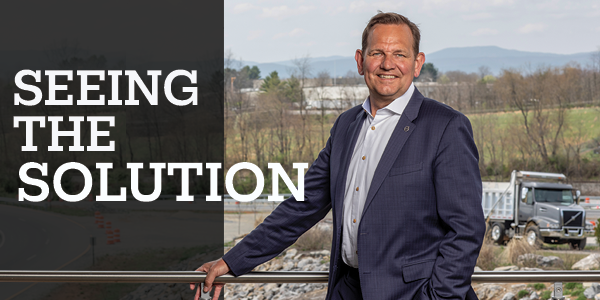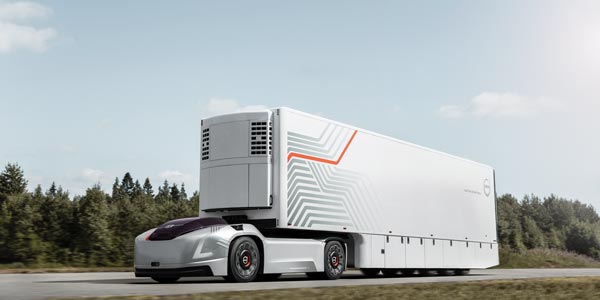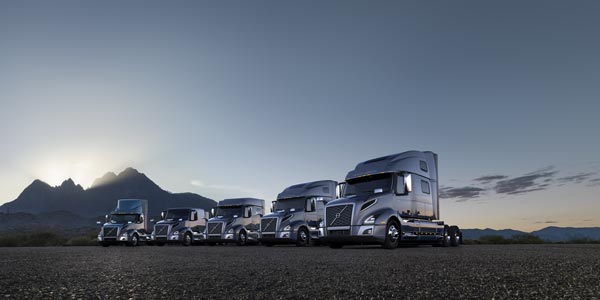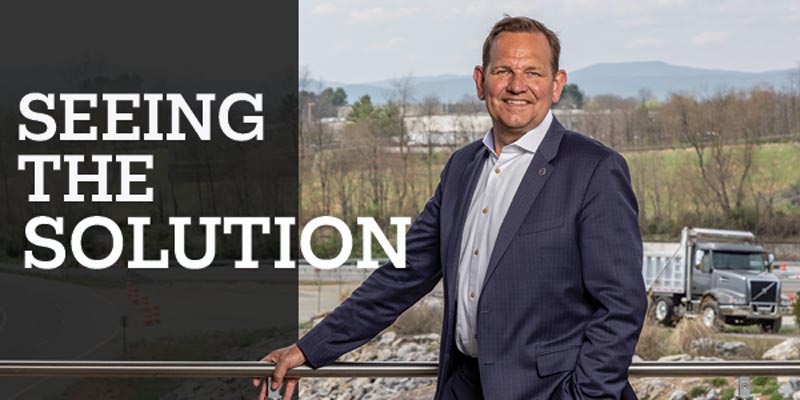
Peter Voorhoeve is a quick learner. He has to be.
The former head of Volvo Group Australia was named Volvo Trucks North America President last September, and he was thrown into an industry where diesel developments and evolving tractor aerodynamics talking points take a backseat to electric trucks and automated driver assistance systems that will lead to higher levels of self-driving technology.
It would be easy for a newcomer to the North American market to get stuck in “What if” instead of “What is.” But Peter took a more practical approach to his new position.
“I tried to work outside-in starting with the customers,” he explains, taking a rare moment to sit down at his conference table and silence the demands of constant notifications calling for his attention from his stand-up desk.
“What I understand better now than nine months ago are the markets, the dealers, and the customers,” he says. “This is the largest, most dynamic truck market in the world, without a doubt, and here we see so many successful, family operated businesses; it’s good to see how professional these businesses are, it is fantastic to figure out how we can help them, and it’s, of course, encouraging to see how our core values align with their operations.”
Despite Peter’s heavy responsibilities, when he sits across from you and you feel the focus of his piercing, bright blue eyes, you know he’s placed his undivided attention on you—your concerns, your questions, your need for ROI.
“Because nobody buys a truck because of my blue eyes anymore,” he says with an easy laugh and disarming smile.
“But we’re all commercial operations,” his tone comfortably shifts back to business, “and one of my greatest concerns after talking with customers is not so much what you see over there,” he points to a Volvo VNL Globetrotter, outfitted with the latest aerodynamic package, polished wheels, high-end seating, and creature comforts like a refrigerator, inverter and parking cooler package, “but rather who is sitting inside: the driver. I’m not only talking about the driver shortage but also the image of the profession itself.”

Peter recognizes the important role equipment can play in a fleet’s driver retention and recruitment programs because he’s heard it from his customers.
“When I hear driver retention rates ranging from 30% to 80%, the amount of replacement drivers my customers need to hire is very, very costly,” he says. “They turn to me and say, ‘Listen, one of the driver incentives in our program is the opportunity to drive your trucks.’”
Listening is a key component of both Peter’s and Volvo Trucks’ product development and deployment strategy.
“With our new trucks—the VNL, VNR and VNX—we built those trucks around the driver with our customers,” he says. “We invited them to customer clinics when we were designing them, and now, I hear them saying, ‘This is fantastic. We said: ‘No, this feature needs to be here, that needs to be there.’ And you did it.’”
Catering to drivers’ demands for more time at home and meeting growing consumer demand for last-mile delivery has resulted in noticeable regional haul growth.
“We’ve seen VNR sales increase significantly in the regional segment. VNR builds have more than tripled since we brought the new product to market,” Peter reports. “Now, I think that also has to do with the fact that new regional product is maybe better geared towards this regional haul work compared to our previous model. If I may say it like that. But certainly, I see customers going from a VNL to a VNR because they start to work with open spoke distribution systems.
“We’re developing electric truck technology, but we stress that the electricity needs to come from renewable energy.”
Peter Voorhoeve, president, Volvo Trucks North America
“I think we’ll continue to see more and more hubs.”
More hubs. More trucks. More routes. It all necessitates more drivers and an increased need for uptime. When a truck goes down with an unexpected service issue, everyone—fleets, drivers and customers alike—feels the pain.
“We know that if we improve uptime that customers will come back,” Peter says. “So how do we do that?”
He gazes out of his office’s floor-to-ceiling windows to the building a half-mile walk away—the 123,000-sq.-ft. North American Volvo Trucks Uptime Center that is home to more than 700 employees that bring together Volvo’s connected services (Volvo Action Service, ASIST, Remote Diagnostics and Remote Programming) alongside crucial departments such as engineering and warranty services. People—real, knowledgeable people—watch for fault codes and proactively reach out to customers, drivers, dealers to coordinate the complex logistics of getting a truck fixed quickly, every minute of every day.
“We need to be there, we want to be there, and, in fact, we are there when a truck experiences issues,” Peter says confidently. “We have 175,000 connected Volvo trucks driving around in the North America alone. We’re able to see when the truck needs service based on remote diagnostics and then optimize our service programs. We reach out and call the customer when we see a problem; ask them if they want to bring the truck in. Then we can check with our dealers and ask them, ‘Do you have time for this truck?’
“And the functionality within connectivity, remote diagnostic and over-the-air powertrain component updates is just getting started. You could say that the industry has been talking about connectivity for the past two years or so, but manufacturers might have talked about how many connected vehicles they had, but to be honest, nobody did anything with the connectivity. Now it’s happening.
“The speed of change today is—” Whoosh! Peter’s arm darts out, his head turns as if the change he was talking about just passed by. “We feel like change happens fast for us, but it’s happening for our customers and their drivers just as quickly.”
Think about your own fleet equipment planning conversations. Electric trucks and self-driving technology were fun things to speculate about a year ago; today, we all take them a little more seriously. Are you buying an electric or self-driving truck tomorrow? No. But is it two or three equipment cycles away? That’s a far more interesting question.

So what’s Peter’s take?
“I don’t think that diesel will disappear that quickly,” he says. “I think you will see electricity coming in, first of all in urban applications, regional applications, like what we’re doing in LA for the Volvo LIGHTS project with the Port of Long Beach and the Port of L.A. From the Port to a warehouse and back again.”
The reasons are numerous, but the two standouts are the lack of electrical charging infrastructure and battery density.
What’s battery density?
Think about it like your diesel fuel tank—battery density is the amount of energy (fuel) a battery bank can deliver. Today, most OEMs agree the range of acceptable battery banks can deliver somewhere in the neighborhood of 200 to 300 miles. You could go further by adding more batteries, but that would add more weight and cut into your load capacity. Improvements to battery density mean the ability to store more energy in smaller packages—much like your cell phone battery compared to the original mobile phone.
And how often do you complain about your smartphone not holding a charge? That is not a complaint you want to be voicing with an electric truck. Peter takes a realistic, application-based approach when discussing Volvo’s in-development technology.
“The charging infrastructure isn’t there for long-haul applications either,” he says. “And in all fairness, if you’re being pragmatic, I think the air in the Port of Los Angeles and Long Beach Port will be improved by electric trucks. The air between Chicago and L.A. would be helped as well, but the immediate issues are in concentrated areas such as Southern California. So we need to attack the problem where it exists, to start.”
Air quality might not concern you (unless you’re operating in California), but for Peter, reducing emissions and improving air quality is a big component of Volvo Trucks’ electric vehicle development because it offers a path away from reliance on fossil fuels.
“We’re developing electric truck technology, but we stress that the electricity needs to come from renewable energy,” Peter says firmly. “In terms of wind and solar power, I think investments are paying off because solar cells are becoming significantly cheaper now, windmills are becoming cheaper and more efficient. These developments point in one direction: electromobility.”
That might be true for tomorrow, but today, diesel is still king, and diesel developments can get lost in the technology conversation. But not for Peter.
“Diesel will still be there,” he reiterates. “It’s important for us to say that we are investing heavily in new technology, electromobility, autonomous driving—but that doesn’t mean that we stopped investing in diesel developments.”
It wasn’t so long ago that manual transmissions made up the bulk of most OEM builds, but today Volvo Trucks’ automated manual transmission, the I-Shift, makes up 90% of the build spec within trucks employing a Volvo engine; Volvo engines make up 90% of the OEM’s overall builds. Integrated power is here, and there are still plenty of benefits to be unlocked.
Advanced driver assistance and automated systems, for example, work with the components and systems that are currently on today’s trucks.
“When we talk about autonomous trucks we focus on a couple of things. First, we say that on all levels of autonomy, our trucks will work as expected because, at the end of the day, we want to help the driver be as safe and comfortable as possible. Talking about Level 4 technology—where the truck can drive without the driver—we strongly believe that, in the beginning, adoption will start within contained-area applications.”
Need an example? How about a real life one?
Volvo already has Level 4, self-driving, off-road, 16-liter trucks hauling limestone in Norway.
“The wheel loader operator calls the truck by pushing a button on his iPad and the truck drives without a driver to the wheel loader where the truck is filled with limestone. Then the wheel loader operator pushes another button and the truck drives to the crusher, backs up, unloads and then drives back to the wheel loader. It operates 24/7 without a driver. That’s a commercial solution.”
It’s technology that’s not based on “when” or “if”—it’s now. It’s happening right now as you read this story. The trick is the application. On-
highway self-driving use cases present far more variables with far higher consequences.
“Automated driving will have very specific applications—logistic centers, for example, where a truck can pick up a container or load and deliver it somewhere else on the property. Once it’s established, it’s a breakthrough technology that, when commercially available, its adoption will increase quickly.
“But I think the majority of fleets understand they cannot jeopardize safety,” he says. “We’ve had those discussions.”
The talks continue, between OEMs, fleets, drivers, technology companies, utility companies. For Peter’s part in the conversation, he’s going to stay focused on application and producing the right tool for the job.
Check out the rest of the June digital edition of Fleet Equipment here.













